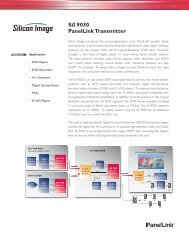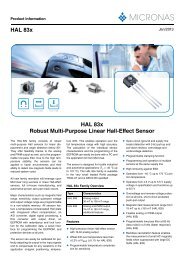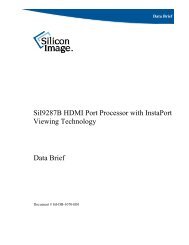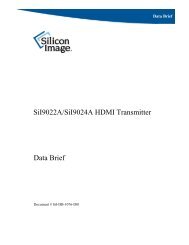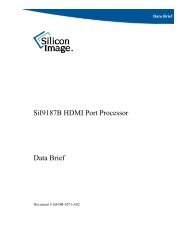You also want an ePaper? Increase the reach of your titles
YUMPU automatically turns print PDFs into web optimized ePapers that Google loves.
ADVANCE INFORMATION<br />
<strong>UAC</strong> <strong>357xB</strong><br />
The previous chapters describe the <strong>UAC</strong> <strong>357xB</strong> from<br />
the hardware point of view. The <strong>com</strong>plete functionality,<br />
however, is defined by the microcontroller firmware.<br />
This firmware tailors the device to a specific application.<br />
Micronas offers two standard firmware versions<br />
embedded in the ROM.<br />
– Type 4: Standard Codec<br />
– Type 2: Standard Headset<br />
Note: It is possible to customize many parameters<br />
(IDs, strings, equalizer setting etc.) by means of<br />
an external EEPROM.<br />
Table 4–1: Programmable Device Descriptor Items<br />
Item Default Type 4 Default<br />
Type 2<br />
idVendor 0x074D 0x074D<br />
idProduct 0x3574 0x3574<br />
bcdDevice 0x000x 1) 0x000x 1)<br />
iManufacturer 0x01 0x01<br />
iProduct 0x02 0x02<br />
iSerialNumber 0x00 0x00<br />
1) Changes with firmware revisions<br />
Both firmware versions are very similar. Differences<br />
are mentioned in the following chapters.<br />
4.1. Features<br />
The main features of the standard firmware versions<br />
are:<br />
– USB playback and record with independent sample<br />
rates<br />
– Sample rates from 6.4 kHz to 48 kHz<br />
– Microphone or Line input<br />
(only mic for Type 2)<br />
– Audio baseband processing incl. dynamic bass<br />
management<br />
– Basic audio control by GPIO-HID<br />
– Suspend mode and remote wake-up support<br />
– I 2 C master/slave support<br />
– Bootloader permitting download of configuration<br />
data, plug-ins or <strong>com</strong>plete firmware (only for<br />
<strong>UAC</strong> <strong>357xB</strong>) after power-on<br />
– Plug-in support (downloadable firmware extensions<br />
from external EEPROM or WIN driver).<br />
Most of the functions are defined in the device and<br />
configuration descriptor. The following chapters provide<br />
all noteworthy information, which is buried in this<br />
descriptors. It is assumed that the reader is familiar<br />
with the basic USB notation (USB Spec 2.01/<br />
www.usb.org).<br />
4.2. Device Descriptor<br />
The device descriptor contains the downloadable IDs<br />
and the index for several strings.<br />
Associated to the string index there are three programmable<br />
strings. The ROM firmware defines only two:<br />
Table 4–2: Strings<br />
String Default Type 4 Default Type 2<br />
Manufacturer<br />
String<br />
Micronas<br />
4.3. Configuration Descriptor<br />
Micronas<br />
Product String Type 4 Type 2<br />
The configuration descriptor contains information on<br />
the bus/self-powered and remote wake-up capabilities.<br />
The <strong>UAC</strong> <strong>357xB</strong> allows all <strong>com</strong>binations of these features.<br />
There is also a string index, allowing to associate<br />
a string to this configuration. The default string is a<br />
date code (time of code assembly). These items are<br />
programmable:<br />
Table 4–3: Programmable Configuration Descriptor<br />
Items<br />
Item Default - Type 4 Default - Type 2<br />
iConfig 0x01 0x01<br />
bmAttributes<br />
0xe0<br />
(self-powered,<br />
remote wake-up)<br />
0xa0<br />
(bus-powered,<br />
remote wake-up)<br />
MaxPower 0x00 (0 mA) 0x32 (100 mA)<br />
The configuration descriptor also provides all information<br />
concerning the audio flow in the Class Specific<br />
Audio Control Interface. Fig. 3–1 on page 18 shows<br />
the graphical representation for the codec firmware.<br />
Micronas Aug. 20, 2004; 6251-650-1AI 23


